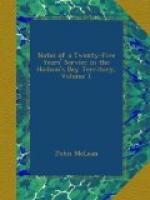The winter dress of the Nascopie consists of a jacket of deer-skin, close all round, worn with the hair next the skin, and an over-coat of the same material reaching to his knees, the hair outside. This coat overlaps in front, and is secured by a belt, from which depends his knife and smoking-bag. A pair of leather breeches, and leggings, or stockings of cloth, protect his legs, though but imperfectly, from the cold; his hands, however, are well defended by a pair of gauntlets that reach his elbows; and on his head he wears a cap richly ornamented with bear’s and eagle’s claws. His long thick hair, however, renders the head-gear an article of superfluity,—but it is the fashion. The dress of the women consists of a square piece of dressed deer-skin, girt round them by a cloth or worsted belt, and fastened over their shoulders by leather straps; a jacket of leather, and cloth leggings. I have also observed some of them wearing a garment in imitation of a gown. The leather dresses, both of men and women, are generally painted; and often display more taste than one would be disposed to give them credit for.
The travelling equipage of the Nascopies consists of a small leather tent, a deer-skin robe with the hair on, a leather bag with some down in it, and a kettle. When he lies down he divests himself of his upper garment, which he spreads under him; then, thrusting his limbs into the down bag, and rolling himself up in his robe, he draws his knees up close to his chin; and thus defended, the severest cold does not affect him.
Considering the manner in which their women are treated, it can scarcely be supposed that their courtships are much influenced by sentiments of love; in fact, the tender passion seems unknown to the savage breast. When a young man attains a certain age, and considers himself able to provide for a wife—if the term may be so debased—he acquaints his parents with his wish, and gives himself no further concern about the matter, until they have concluded the matrimonial negotiations with the parents of their, not his intended, whose sentiments are never consulted on the occasion. The youth then proceeds to his father-in-law’s tent, and remains there for a twelvemonth; at the end of this period he may remain longer or depart, and he is considered ever after as an independent member of the community, subject to no control. Marriages are allowed between near relatives; cousins are considered as brothers and sisters, and are addressed by the same terms. It is not considered improper to marry two sisters, either in succession or both at the same time.
The Nascopies have certain customs in hunting peculiar to themselves. If a wounded animal escape, even a short distance, ere he drops, he becomes the property of the person who first reaches him, and not of the person who shot him; or if the animal be mortally wounded and do not fall immediately, and another Indian fire and bring him down, the last shot gains the prize.




